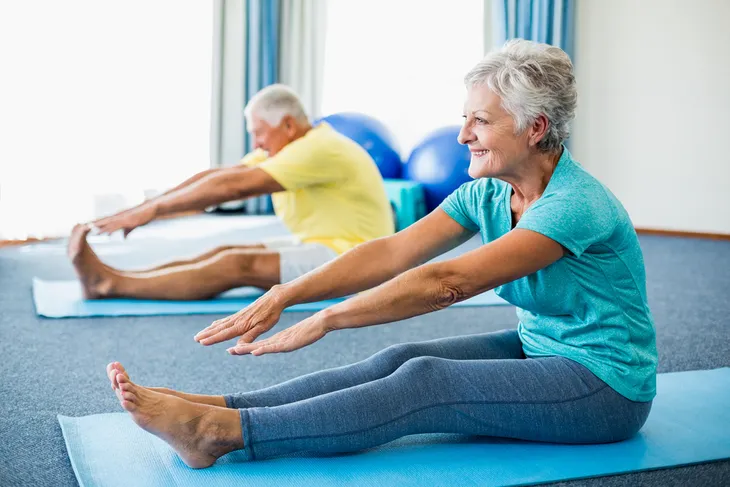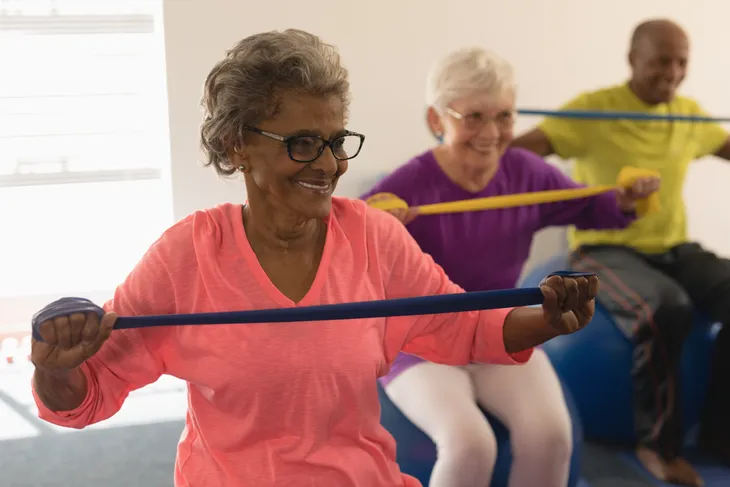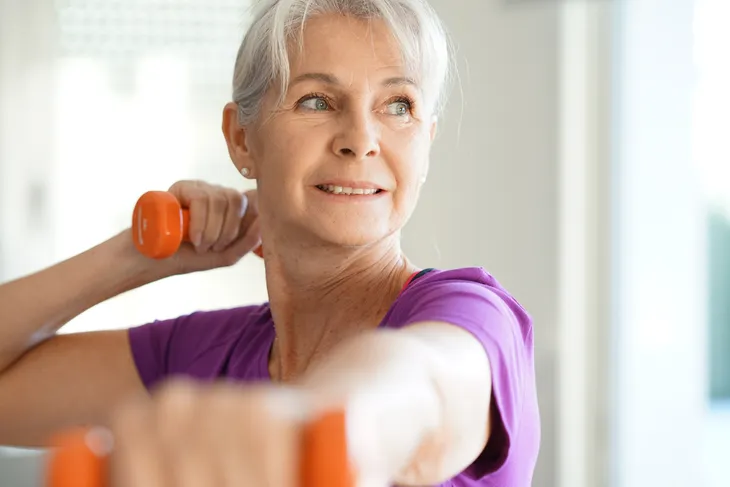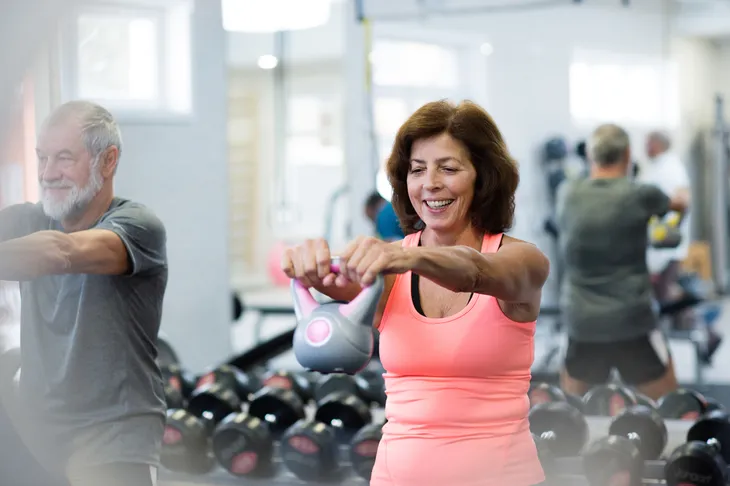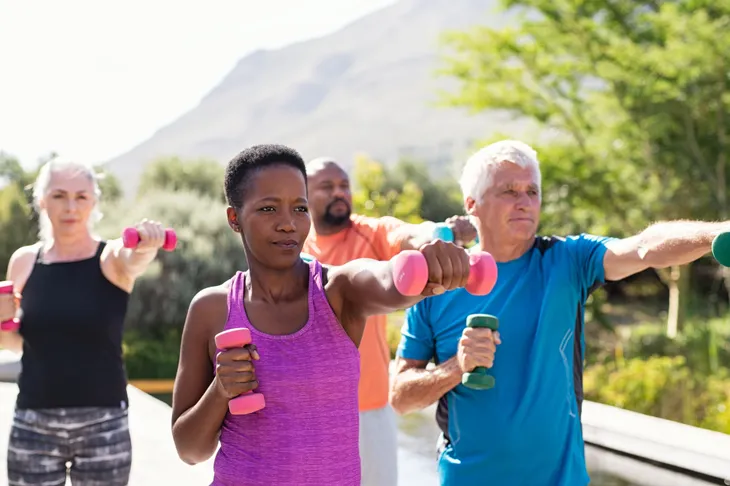Any resistance-based exercise which includes weightlifting, is an excellent way to maintain muscle strength, muscle mass, and encourage good health with age. Most people shy away from weightlifting as they get older because they think it can be damaging, but this isn’t true! All it takes is a little more care and consideration.
As long as you consult either a physiotherapist or personal trainer, seniors can safely lift weights and enjoy all the benefits that come along with it! Here are our top 10 weightlifting tips for people over the age of 50 from our expert Eric Leckie…
Do a Warm up and Cool Down
The key to avoiding injury and building muscle is to get a good warm in up before you start your workout. The sign of a good workout is if you’re able to break a sweat. This shows that your muscles are nice and warm, and ready to go! If you don’t warm them up before a workout, you’ll be more prone to injury or stiffness afterwards.
Just as warm ups are important, so are cool downs. Unfortunately, most people skip this part of a workout but it’s one of the most important. Cool downs allow the heart rate to slowly return back to normal and help prepare the body for proper recovery after any exercise session, particularly one with weightlifting. Aim for a 5-minute walk on a treadmill or even just 5-minutes of stretching.
Activate the Muscles
Once a warm up is complete, it’s important to activate any muscle groups you’re about to workout. This will help to not only reduce any risk of injury, but also helps prime the body so that it can reap all the benefits of weightlifting.
The best way to activate muscles is to use a resistance band and focus on movements that use the main muscle groups you’re about to train. (You should also check out our article on Resistance Band Exercises for Seniors [With Video]).
Focus on Proper Form
Proper form is extremely important which is why working with a trainer might be a good idea, especially if you’re new to weightlifting. The best way to check up on your form is to perform the exercises in front of a mirror. Don’t worry about being vain — proper form is key to avoiding injury and reaping the benefits of each exercise.
Watch yourself in the mirror as you perform in repetition in your workout. This will help ensure you have perfect form and allow you to make any adjustments as needed.
Stay Hydrated
Drinking water is always important, but it’s especially important when working out! Particularly when you’re challenging your body with any kind of resistance training like lifting weights. We suggests aiming to drink at least one to two glasses of water during a workout to keep the body nice and hydrated.
Weightlifting works many different muscle groups, so your body will need more water intake to stay hydrated and functioning properly.
Record The Weights You Used Each Workout
To ensure that you’re making progress with your workouts it might be a good idea to record the weights you’ve used for each workout. You can do this either with your phone or notepad. This will help you stay consistent with your weights and maybe help indicate when it’s an appropriate time to increase the weight for certain exercises.
Avoid Injury
Avoiding injury is always a concern when working out, but as we age we need to take extra precaution against this because our bodies are a little more fragile. We might not be able to push the same boundaries that we could when were were 20-years-old.
If you’re training and you feel a slight niggle or muscle strain, it’s a good idea to just call it quits for the day. Don’t try to push through it. Stopping early can prevent a week of misery and pain from an injury. The older a person gets, the more important it is to take care of your body. (Check out Tips to Sidestep Fitness Injuries).
Find a good physiotherapist who can help with any of these niggly injuries. You must remember that you’re not twenty years old anymore. If you’re training and you feel a slight niggle or muscle strain, it’s best to call it quits for the day. Stopping early can prevent you from a week of misery and pain. The older you get, the more important taking care of your body becomes. Find a good physiotherapist to stay on top of any niggly injuries.
Add in Recovery Days Between Sessions
Adding in recovery days between your weightlifting sessions is a great way to allow the body to recover and continue building strength and muscle. However, this doesn’t have to be a complete day off from exercising. You can grab a friend and head out for a brisk walk or go for a light swim to kick start your body’s recovery process.
Proper Rep and Set Ranges
For most people who are interested in lifting weights their goal is likely to improve strength. To accomplish this, you should aim for two to three sets of less than six repetitions of each exercise. On the other hand, if you’re looking to build muscle, then you should aim for three to six sets of 6 to 12 repetitions.
Not sure how to set up a proper workout plan? Seek assistance from either a personal trainer of physiotherapist. They are more than qualified to help!
Focus on Muscle Contraction & Don’t Rush
The old saying “focus on quality not quantity” stands true when weightlifting. Because you’re lifting heavy weights, you stand a higher chance of getting injured. To minimize any risk of injury and get good results from your efforts, make sure every repetition is of good quality and that you can feel every muscle contract during each exercise.
The National recommendations for adults over the age of 50 is 2-3 resistance based (weightlifting) workouts each week focusing on the major muscle groups of the body.
If you’re a beginner, you likely won’t be able to just jump right in and start lifting weights like you did when you were in high school. But, if you follow the tips we just provided and seek help from a qualified professional, there’s no reason why someone over the age of 50 can’t start lifting weights. They’ll help you get stronger and build more muscle. So, visit your local gym, book an appointment with a personal trainer, and get a customized exercise plan that is tailored to your goals and needs!

